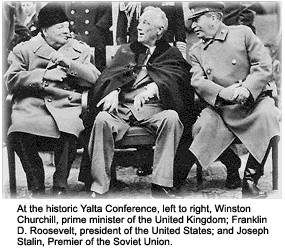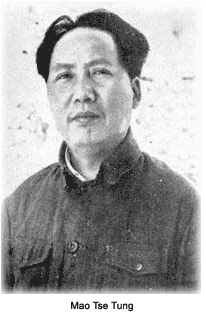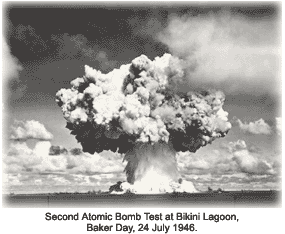Conflicts of national interest caused the World War II alliance between the United States and the Soviet Union to be replaced by a Cold War that lasted 45 years. Initially a dispute over the future of Europe, it grew to include confrontations around the world.
Following the Casablanca Conference at the height of World War II unity in 1943, President Franklin D. Roosevelt assured the American people that any thought of a breakup of the wartime alliance with the Soviet Union was simply Nazi propaganda:
Cold War confrontations were nearly always conducted through surrogates — or by economic pressure, selective aid, diplomatic maneuver, propaganda, assassination, low-intensity military operations — in order to avoid a direct confrontation that could have led to a nuclear war. In fact, on several occasions, the two nations came close to just such a holocaust, for example the Cuban Missile Crisis, but through both luck and strategy they managed to avoid it.In an attempt to ward off the inevitable disaster, the Axis propagandists are trying all of their old tricks in order to divide the United Nations. They seek to create the idea that if we win this war, Russia, England, China, and the United States are going to get into a cat-and-dog fight. This is their final effort to turn one nation against another in the vain hope that they may be settling with one or two at a time -- that any of us may be so gullible and so forgetful as to be deuped into make "deals" at the expense of our allies.
Never having been declared, the Cold War did not end on a single agreed date, but it can reasonably be said that it ended with the creation of a united, independent Germany in October 1990, the most important issue of its origins.
There has been some controversy over the phrase "Cold War." Most historians attribute it to Bernard Baruch, who first used it in a speech on April 14, 1947. Some claim that the term can be traced to George Orwell, but Orwell used the phrase generically and not specifically in connection with the Soviet Union and the United States.
Baruch should be regarded as the originator of the term "Cold War" within the meaning in which it became universally accepted. Influential author Walter Lippmann wrote many books, including Cold War, which in 1947 aided in coining its name.
The wartime alliance between the Soviet Union and the United States was a marriage of convenience. The United States had provided military assistance to the Tsarist regime, known as the White side, that had attempted to topple the Bolsheviks after Vladimir Lenin’s withdrawal from World War I and had waited until 1933 to grant diplomatic recognition to the Soviet government.
When Joseph Stalin signed the Nazi-Soviet Pact in 1939, Stalin left the West to fend for itself, but when Hitler abandoned the treaty and invaded in 1941, the West concluded that they could not afford for Germany to acquire so much territory and resources. "If Hitler invaded Hell, I would make at least a favorable reference to the devil in the House of Commons," was Winston Churchill’s famous remark. Thus the wartime alliance was born.
World War II ends
As the war drew to a close, the Soviet Union made it clear that they considered Eastern Europe to be within their sphere of influence and an impotent Germany to be a non-negotiable outcome of the conflict. To ensure their objectives, the Soviet Union established the Soviet Alliance System in 1943, which enabled them to institute military and political control over Eastern European countries.
With the formation of the Warsaw Pact alliance through the signing of the Treaty on Friendship, Cooperation, and Mutual Assistance in 1955, Red Army soldiers flooded Bulgaria, Czechoslovakia, Hungary, Poland, and Romania to create a “buffer zone” from possible future attacks to the Soviet Union from the west.
The war`s cost in lives to the Soviet Union had been enormously greater than that of the United States. The latter had suffered some 400,000 deaths, almost all in the active military. Some 25 million Soviet citizens died, the majority of them civilians.
The Soviets were resolved that Germany would never invade their country again. After having been invaded by Germany three times in the last 150 years, the U.S.S.R. would do everything within its power to ensure Germany’s powerlessness. The Soviets would also not soon forget that their demand for a second front in the west during World War II, had been denied for two years of severe losses before the Allied invasion took place in 1944.
 For its part, the United States had used altruistic rhetoric to explain its war objectives. Self-determination for all people was one of the cornerstones. While conceding the expected Soviet hegemony over the countries on its western border, at the Yalta Conference in February 1945 (where the Cold War supposedly began), the United States was able only to extract promises that pluralistic governments would be allowed there.
For its part, the United States had used altruistic rhetoric to explain its war objectives. Self-determination for all people was one of the cornerstones. While conceding the expected Soviet hegemony over the countries on its western border, at the Yalta Conference in February 1945 (where the Cold War supposedly began), the United States was able only to extract promises that pluralistic governments would be allowed there.
As the Soviet Union`s intent to crush non-communist opposition groups in Eastern Europe became evident and with a build-up of one million Red Army soldiers within those countries, America’s concern grew.
Expansion of communism
Weakened by World War II fighting, the British informed the U.S. government in February 1947, that the British could no longer provide financial aid to the Greek and Turkish governments. Greece was in the middle of a civil war and Turkey needed assistance with modernizing its society.
Concerned that both countries could fall into the Soviet sphere of influence, undersecretary of state Dean Acheson presented an idea in a meeting with Congress that would later become known as The Domino Theory. His notion was that when one nation falls to communism, neighboring states are weakened and eventually fall themselves.
America`s concern was heightened when the Soviets pressured Turkey for concessions involving the Dardenelles Strait that would allow access to the west through the Caspian Sea. The Truman Doctrine enunciated its support of U.S. aid to Greece and Turkey while stating for the first time that U.S. policy was opposed to the expansion of communism anywhere in the world.
Following Stalin`s decision to blockade West Berlin to gain control of the city, the United States and Britain responded with the successful Berlin Airlift of food and supplies to West Berlin citizens between 1948 and 1949. At no time, except perhaps during the Cuban Missile Crisis, did the Cold War bring the world so close to direct hostilities between the major powers.
 The rise to power of Mao Zedong and the People`s Republic of China demonstrated that communism could exert an influence far beyond the industrialized West, where Marx and Lenin had expected it to triumph. Although Acheson had suggested early in 1950, that Korea lay outside the defense periphery of the United States, the invasion of South Korea by the North in June 1950 was too blatant to be ignored.
The rise to power of Mao Zedong and the People`s Republic of China demonstrated that communism could exert an influence far beyond the industrialized West, where Marx and Lenin had expected it to triumph. Although Acheson had suggested early in 1950, that Korea lay outside the defense periphery of the United States, the invasion of South Korea by the North in June 1950 was too blatant to be ignored.
Assuming the invasion had taken place with the knowledge and support of the Soviet Union and China, the United States responded forcefully. The Korean War was fought to an eventual draw by United Nations forces, of whom the majority were American troops.
Nuclear arms race
For their part, the Soviet Union had regarded the United States` exclusive possession of nuclear weapons as a strategic threat. When the Soviets exploded their own atomic bomb in 1948, the United States embarked on a crash program to produce the exponentially more powerful H-bomb, against strong opposition from one of its creators J. Robert Oppenheimer and chairman of the U.S. Atomic Energy Commission David Lillienthal. However, within a year of the first American H-bomb test, the Soviets exploded one of their own.
Nevertheless, the United States continued to hold a wide numerical advantage in nuclear weapons throughout the 1950s, producing technically superior weapons with the aid of advances in computers, while the Eastern bloc produced a larger number of many types of weapons.
America’s sense that global distances protected it from the worst risks, however, was shattered in 1957 when the Soviet Union launched Sputnik, and showed that their missile technology had given them the theoretical ability to reach American targets with a delivery system against which no known defense existed.
For the next decade, both nations continually produced more nuclear weapons and more sophisticated missiles to deliver them. By the late 1960s, with the development of MIRVs (multiple independently targeted reentry vehicles), the weapons race had provided each side with "overkill."
Nuclear arms reduction
As a result of the overkill condition and fears that non-nuclear nations would acquire weapons of mass destruction, the Treaty for the Non-Proliferation of Nuclear Weapons, better known as the Nuclear Non-Proliferation Treaty or NPT, was signed on July 1, 1968, by the United States, Soviet Union, United Kingdom, and 59 other countries. The treaty defined two categories of nations: Nuclear nations were those who had already tested the atomic bomb, and non-nuclear nations were all others.
Non-nuclear nations that sign the treaty are obligated to open their (non-weaponry) nuclear facilities to inspection by the International Atomic Energy Agency and to agree to safeguards that will guarantee that nuclear technology and materials are not diverted to military uses. The nuclear nations agree not to assist non-nuclear nations in the development of nuclear weapons.
The two countries came close to direct confrontation twice in the 1960s, the first involving Cuba`s Fidel Castro, in the failed Bay of Pigs Invasion of Cuba in April 1961.
The second occasion was the Cuban Missile Crisis of October 1962, when President John F. Kennedy played brinksmanship* with Soviet Premier Nikita Khruschev over offensive missile installations in Cuba. At the last moment, a compromise, which included the removal of offensive nuclear weapons from both Cuba and U.S. ally Turkey, was reached and nuclear war was averted.
Détente
The futility of a permanent, unrestrained arms race led the two sides to begin negotiations to limit the number of nuclear weapons and missiles stockpiled. As a result of "Detente," President Richard M. Nixon was invited to talks with General Secretary Leonid Brezhnev in Moscow that resulted in the Strategic Arms Limitation Talks, commonly known as SALT, and the first arms limitations treaty was signed in 1972.
The talks took place in two phases: SALT I ran from 1969 to 1972 and resulted in the Anti-Ballistic Missile Treaty and the "Interim Agreement Between the United States of America and the Union of Soviet Socialist Republics on Certain Measures With Respect to the Limitation of Strategic Offensive Arms."
Four days later, the two leaders signed the Basic Principles of Relations between the United States and the U.S.S.R. That agreement called for peaceful co-existence, the avoidance of military confrontations, and no claims of spheres of influence. SALT II, begun in late 1972, produced a treaty that was never ratified by the U.S. Senate.
One hoped-for outcome of détente had been to provide the United States with a graceful exit from the Vietnam War, but that did not happen. The war had been undertaken to demonstrate that the United States would not permit any more countries to be "lost" to communism and was generally popular for its first years, but after the failure of the Tet Offensive in early 1968, public opinion in the United States shifted.
Nixon hoped for an exit that would preserve its client state in South Vietnam, but eventually, the United States withdrew and was obliged to watch helplessly as North Vietnamese forces overran Saigon in 1975.
 Détente, the French word for the relaxation of tension, was unfortunately viewed differently by the two superpowers. The United States believed that the Soviet Union had agreed to a worldwide standoff, while the Soviets considered it their obligation to continue to support revolutions anywhere in the world against what they regarded as oppression.
Détente, the French word for the relaxation of tension, was unfortunately viewed differently by the two superpowers. The United States believed that the Soviet Union had agreed to a worldwide standoff, while the Soviets considered it their obligation to continue to support revolutions anywhere in the world against what they regarded as oppression.
Those strains gradually frayed the relationship and détente finally broke down with the Soviet invasion of Afghanistan in 1979, which some felt was an unprovoked attack on a sovereign nation. The CIA had spent $10.1 million to establish an anti-Soviet resistance movement in Afghanistan over a 10-year period.
President Ronald Reagan campaigned during the 1980 election on a strong, anti-communist platform. During his first years in office, he brought about the largest peacetime military build-up in the nation`s history. He instituted the policy of supporting movements that opposed such communist regimes as the Soviet-backed government of Afghanistan.
Reagan`s uncompromising rhetoric and his evident willingness to engage in brinksmanship brought about the end of détente as President Nixon had envisioned it and caused concern at home and among America`s European allies. In 1982, President Reagan abandoned SALT and undertook the Strategic Arms Reduction Treaty talks, commonly known as the START talks, instead.
Cold War Thaws
Conditions inside the Soviet Union and its relations with the United States dramatically changed with the accession of Mikhail Gorbachev to the position of General Secretary of the Communist Party of the Soviet Union. Gorbachev viewed the arms race as a vestige of obsolete thinking and that beyond a certain point, which had already been reached and passed, increases in military power were useless.
With the introduction of Gorbachev’s policies of glasnost, or openness, and perestroika (economic restructuring), more personal freedoms were given to its citizens and a friendlier environment towards international commerce arose. Realizing that his nation’s economy was on the brink of collapse, Gorbachev began to offer concessions to American negotiators and even announced a unilateral reduction in Soviet troop strength. In short order, the arms race came to an end.
In addition, Gorbachev made it clear in December 1988, that he no longer intended to enforce the Brezhnev Doctrine that no satellite country in Eastern Europe would be allowed to defect from the Soviet sphere.
With startling speed, democratic movements emerged throughout the region in 1989, with the last regime falling in Romania before the end of the year. When Gorbachev pulled troops out of Afghanistan that same year, he announced that “the postwar period is over.”
In November 1989, the most symbolic evidence of the Cold War, the Berlin Wall, was torn down. As the two Germanys moved toward reunification, the Soviet Union was faced with the development it had opposed for nearly half a century, a united and prosperous Germany.
Assurances by the United States that Germany would remain within the western security alliance, and the evidence that a non-expansionist democracy had taken root there, persuaded the Soviets to accept reunification in 1990. With the resolution of the issue that had been most responsible for starting the Cold War, that conflict effectively came to an end.